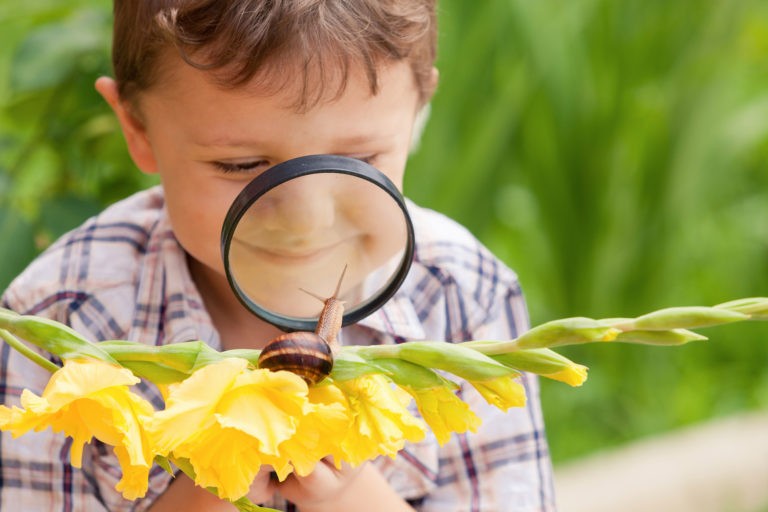No one ever said learning has to be inside four walls! Through our distance learning experience, when the weather got a bit warmer and the sun was shining, it was the perfect excuse to go outside and do schoolwork. No one knows what school will look like in the fall, but these outdoor learning activities can work with distance learning, in school and taking a trip outside, or even some as an at-home assignment!
Math
Bringing math outside can be as simple as a geometry lesson and looking for symmetry in nature. The students can get into small groups, go outside with a clipboard, and search for objects/creatures that display symmetry. Students can sketch and label their findings. A way to enhance this activity would be to allow students to use a cell phone to take photos and share with classmates.
Sidewalk chalk is another great option for outdoor math! Students can make “Fact Family Flowers”! The center of the flower (pistil) is where the basic fact is located and the petals are where the facts and products are listed.
Another cool idea with sidewalk chalk is to create “Product Clouds”. Depending on the grade level, choose the basic math facts you want to practice. Draw the products in clouds with the sidewalk chalk over a somewhat large area, and the teacher can split the students into small groups. The teacher can call out the problem, such as 9 X 9, and one student from each group will race to the cloud with the correct product. For a challenge, the clouds can have estimates instead of actual answers, and the teacher can give more complex two-digit by two-digit/three-digit problems where students can solve with paper pencil, then race to a product cloud with the closest estimate. This is a great activity for your kinesthetic learners.
Science
Science is all around us! You can do a simple bubble lab outside. The teacher can premix three to five solutions of dish soap and water (use different brands) in cups. The students can make predictions on which solution will produce the largest bubbles. You can simply use straws, dip them in the bubble solutions, and blow bubbles through the straws. Students can chart observations on a data sheet and compare/contrast bubble sizes.
A fun extension of this activity can be to make the bubble that lasts for the longest amount of time. Students can use a timer, watch, or cell phone to collect data on the longevity of the bubble and determine which brand has the longest lasting bubbles.
Having a scavenger hunt is also a fun life science activity! The teacher can create a list of items students need to find outside. Students can either sketch or take a photo of the items. It allows students to explore the outdoors and find items in nature!
English Language Arts
Bringing ELA outdoors can make it interesting! You can simply bring students outside for a read aloud. Have a small block of time (10-15 minutes) where you bring your students outside and read one or two chapters of a book to the class each day (weather permitting). You can also have students write in journals or collect ideas for writing narratives or essays outside. Give students a small “Writer’s Notepad” (something pocket sized) where students can store ideas for writing that they can revisit at a later time.
Social Studies
Social studies can also take place outside! Students can create paintings on rocks similar to those made by our early ancestors in caves. If you are doing a unit on Egypt and hieroglyphics, you can have students search for larger rocks to paint messages on. The teacher can incorporate character education into this, as you can write motivational messages in hieroglyphics on the rocks (along with the translation), and leave them outside or around town for others to find.
You can also have students practice their cartography skills outside. Have students create a map of an area outside of the school. Students can use a legend or map key, have the area drawn to scale, use a compass, and incorporate many other mapmaking skills into the activity. Depending on the grade level, you can either make more or less requirements for the map. You can even have students use outdoor items such as rocks, twigs, and grass as points on the map.
The Arts
You can incorporate the arts into outside activities for kids! You can put on a little play. The teacher can find various short scripts from multiple subject areas, put the students in small groups, and have the groups perform for the remainder of the class.
You can also have students create artwork from nature. For example, students could search for twigs and use them to create a tree trunk and branches, and then use leaves to fill out the tree, and pieces of grass, moss, etc. to create the ground the tree sits on. This can all be glued onto a piece of oaktag. Students would be able to get very imaginative and creative with this activity.
Learning can take place anywhere at any time! When you promote student learning outside the classroom, it opens up new doors and adventures for them. It allows you to address many different learning styles while getting fresh air and getting outside the classroom. Sometimes with all the pressure placed on educators, it can be difficult to incorporate fun into learning, and getting outside is one easy way to do so. As Alfred Mercier stated, “What we learn with pleasure, we never forget.” Give students the lessons and learning that they will never forget!




